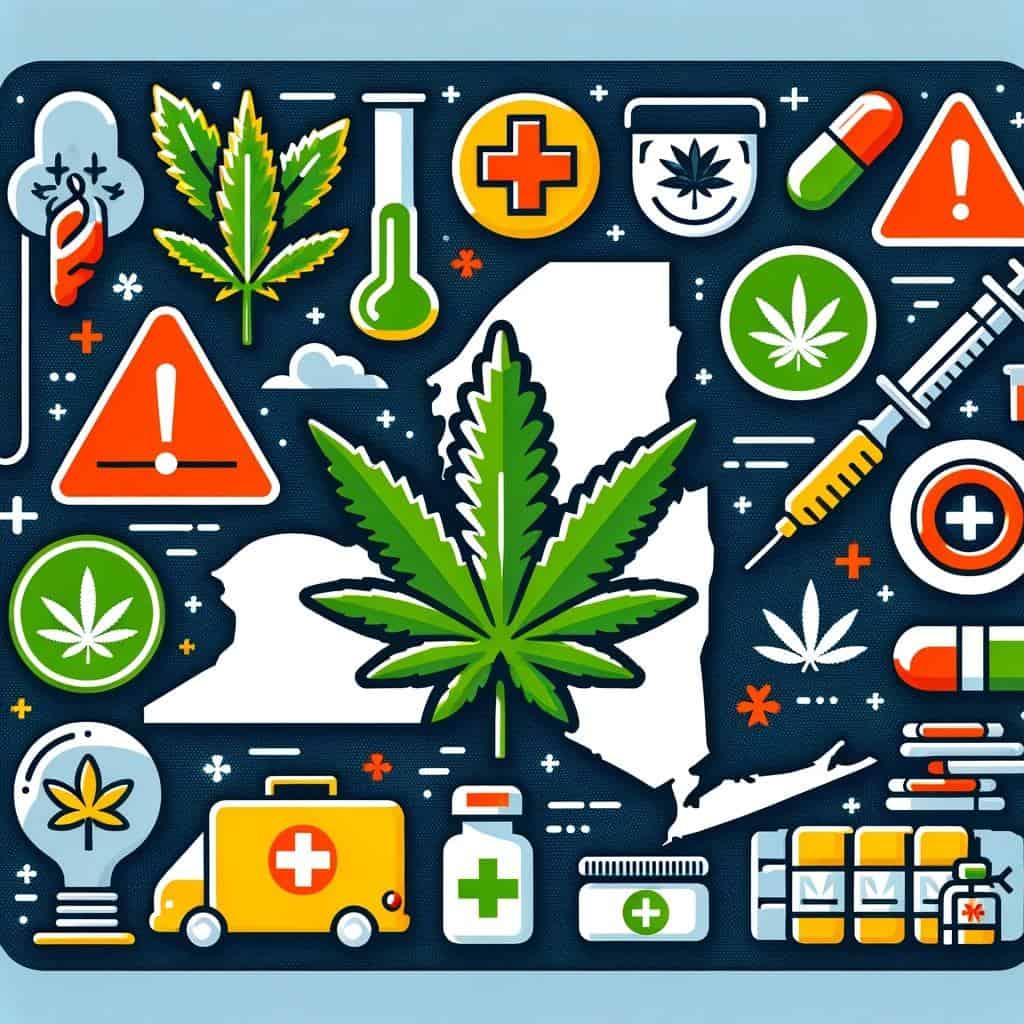- [email protected]
- (619) 304-4004
Explore the safety and adverse effects of medical marijuana in New York, including potential side effects and medication interactions. This blog offers crucial insights for safely navigating medical marijuana use, making it an essential read for informed healthcare decisions in New York’s regulated environment.
Medical Marijuana in New York

In New York, under the Marijuana Regulation and Taxation Act, the use of medical marijuana is carefully regulated for safety. However, patients must be aware of potential adverse effects, such as drowsiness, dizziness, and altered mental states. Crucially, medical marijuana can interact with other medications, impacting their effectiveness and potentially increasing side effects.
This blog provides an essential guide to understanding these risks, particularly for New York’s diverse patient population. It offers insights into managing and mitigating these effects, ensuring patients can use medical marijuana safely and effectively.
This resource is invaluable for anyone in New York using or considering medical marijuana, helping them make informed decisions about their treatment.
The use of medical marijuana, while beneficial for various health conditions, comes with several general safety concerns that users need to be aware of:
Understanding these safety concerns is crucial for anyone considering the use of medical marijuana. Consulting with medical marijuana doctors in New York and using cannabis responsibly are key steps in mitigating these risks.
Common adverse effects of medical marijuana vary depending on the individual, the method of consumption, and the specific cannabis compounds used, particularly THC (tetrahydrocannabinol) and CBD (cannabidiol). Typical side effects experienced by users include:
Individual responses to medical marijuana can vary significantly. Some users may experience few or no adverse effects, while others may be more sensitive. The method of consumption (smoking, vaping, edibles, etc.) also plays a significant role in the type and intensity of side effects experienced.
Users should start with lower doses and increase gradually as needed, and always consult with a healthcare provider, especially if they have pre-existing health conditions or are using other medications.

Patients can identify and manage the adverse effects of medical marijuana through a combination of awareness, careful monitoring, and proactive strategies. Here are some key approaches:
By being attentive to their bodies and staying in close communication with healthcare providers, patients can effectively identify and manage the adverse effects of medical marijuana, ensuring a safer and more beneficial experience.
Certain individuals may be at a higher risk of experiencing adverse effects from medical marijuana due to various risk factors. Understanding these can help in anticipating and managing potential side effects more effectively. Key groups at higher risk include:
Identifying these risk factors allows for a more tailored approach to medical marijuana use, ensuring that those at higher risk are monitored closely and their treatment regimens are adjusted accordingly for safety and efficacy.
To minimize the risk of adverse effects from medical marijuana, patients can take several precautions. These measures are particularly important for those who are at higher risk of experiencing side effects. Here are key strategies to reduce risk:
By taking these precautions, patients can significantly reduce the risk of adverse effects and ensure a safer and more effective use of medical marijuana.

Medical marijuana can interact with other medications in several ways, potentially affecting the efficacy and safety of both the marijuana and the prescribed drugs. Understanding these interactions is crucial for patients using medical marijuana alongside other treatments.
Here’s an overview of common interactions:
Patients using medical marijuana in conjunction with prescription medications should always consult with their healthcare provider.
This ensures that any potential interactions are carefully managed, and treatment plans are adjusted accordingly for safety and efficacy. Regular monitoring and open communication with healthcare professionals are key to navigating these interactions successfully.
To avoid harmful interactions between medical marijuana and other medications, patients can follow several best practices. These guidelines are crucial for ensuring safety and maximizing the therapeutic benefits of all medications involved:
By following these best practices, patients can significantly reduce the risk of harmful interactions between medical marijuana and other medications, ensuring a safer and more effective treatment experience.
The potential long-term effects of medical marijuana use are an area of ongoing research, and understanding these effects is important for individuals considering or currently using medical marijuana.
Some of the key areas of concern and interest include:
It’s important to note that individual responses to long-term marijuana use can vary widely, and research in this area is evolving. Users should approach medical marijuana use with caution, particularly young people and those with a history of mental health disorders. Regular consultation with marijuana doctors is essential to monitor and address any potential long-term effects.
The use of medical marijuana in pediatric patients in New York comes with specific safety concerns and considerations, given the unique physiological and developmental characteristics of children and adolescents. Here are the key safety concerns:
Given these concerns, the decision to use medical marijuana in pediatric patients in New York is made with considerable caution. It involves thorough evaluation by specialized healthcare providers, careful monitoring of the child’s response to treatment, and ongoing assessment of developmental progress.
Parents and caregivers play a crucial role in this process, ensuring adherence to treatment regimens and monitoring for any adverse effects or changes in behavior or development.
Common adverse effects include dizziness, dry mouth, altered mental state, drowsiness, and in some cases, anxiety or paranoia. The intensity of these effects can vary based on the strain and dosage of medical marijuana used.
Start with a low dose and gradually increase as needed, choose the right strain and product, stay hydrated, avoid activities like driving while under the influence, and regularly consult with your healthcare provider.
Potential long-term risks include cognitive impairment, especially when use begins in adolescence, increased risk of psychiatric disorders, dependency, and respiratory issues if smoked. However, research in this area is ongoing.
Medical marijuana is used in pediatric patients only under strict medical supervision, typically when other treatments have failed. There are concerns about its impact on brain development, cognitive function, and mental health in young users.
Yes, medical marijuana can interact with various medications, altering their effectiveness or increasing side effects. It’s important to discuss all medications you’re taking with your healthcare provider to manage potential interactions.
In New York, the use of medical marijuana is carefully regulated, balancing therapeutic benefits with potential safety concerns. Users need to be aware of common adverse effects like dizziness, dry mouth, cognitive changes, and possible anxiety or paranoia.
Starting with low doses, selecting suitable strains, and avoiding activities like driving while under the influence are crucial for safety. Long-term risks, especially cognitive and psychiatric effects in adolescents, call for cautious use and regular monitoring.
The potential for drug interactions necessitates transparent communication with healthcare providers. In pediatric cases, the use of medical marijuana is particularly cautious, considering the impact on brain development and mental health.
While offering significant benefits for certain conditions, medical marijuana in New York demands a careful approach to ensure a balance between its therapeutic efficacy and safety, with close guidance from healthcare professionals.
https://cannabis.ny.gov/patients
https://www.mpp.org/states/new-york/
https://norml.org/laws/new-york-penalties-2/
https://cannabis.ny.gov/practitioners
https://cannabis.ny.gov/medical-cannabis

A1 Marijuana Doctors is an online platform, that connects marijuana patients to marijuana doctors in their state.

A1 Marijuana doctors is an online platform that connects medical patients to medical marijuana doctors. We offer a quick & easy way to apply for a medical marijuana card in all legal states.
Social Links
Contact Us
Quick Links
Trusted By




This website does not sell medicine nor controlled substances. It is a network of doctors & nurse practitioners, not a pharmacy / dispensary.
Copyright ©2023 A1 Marijuana Doctors. All rights reserved.